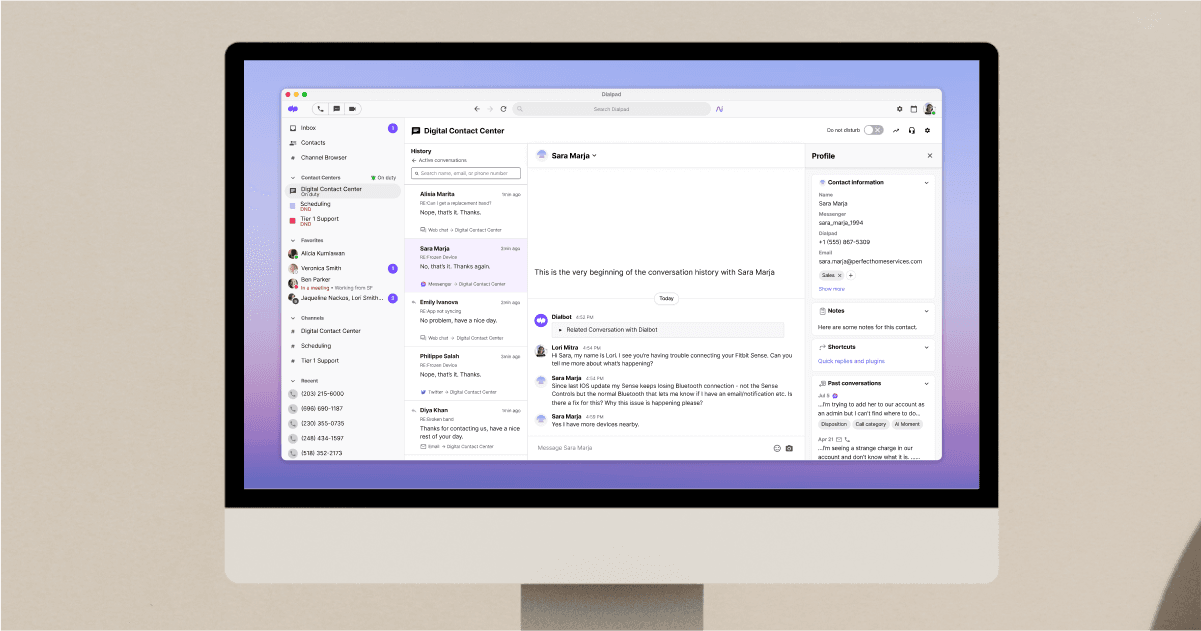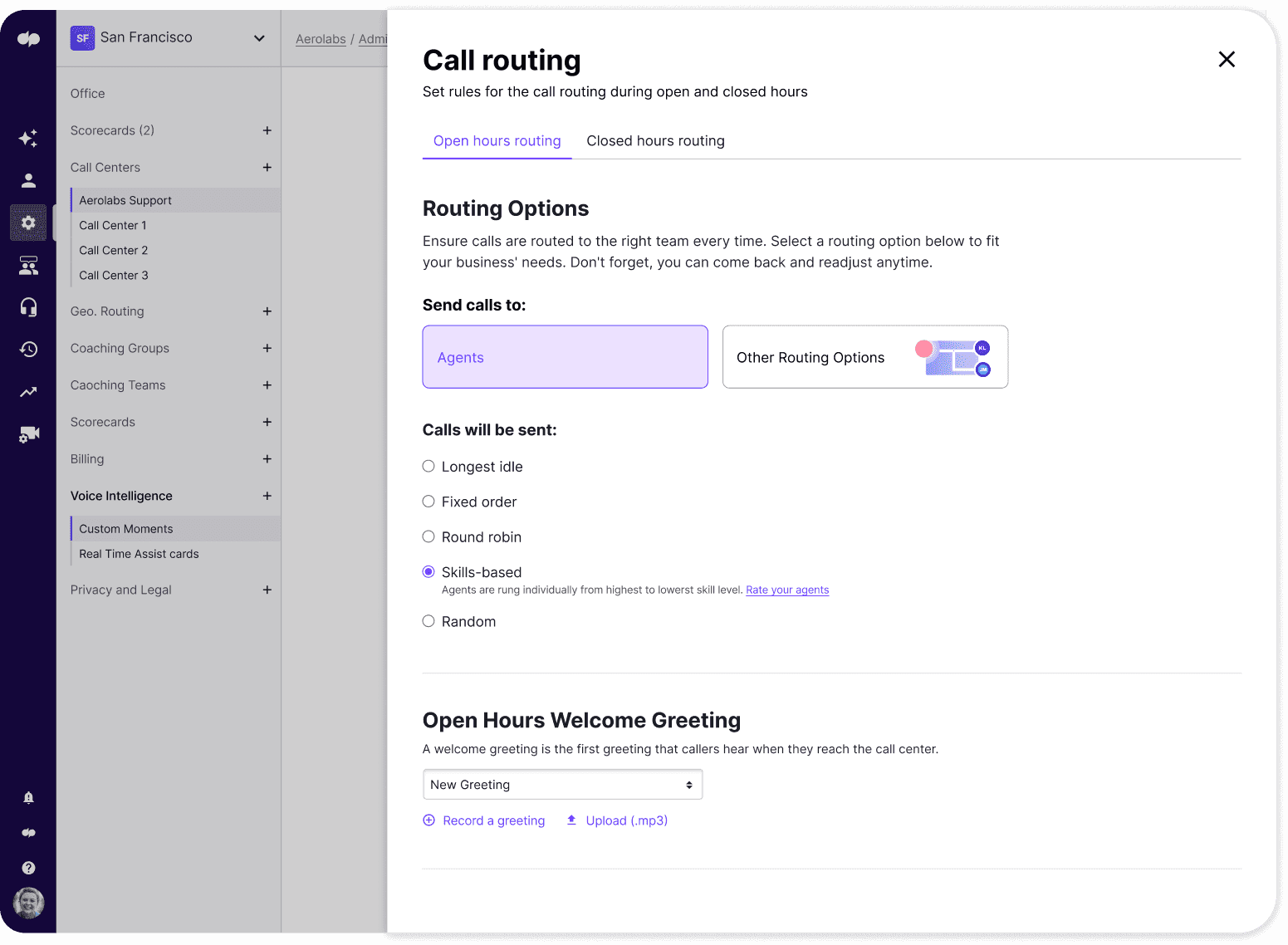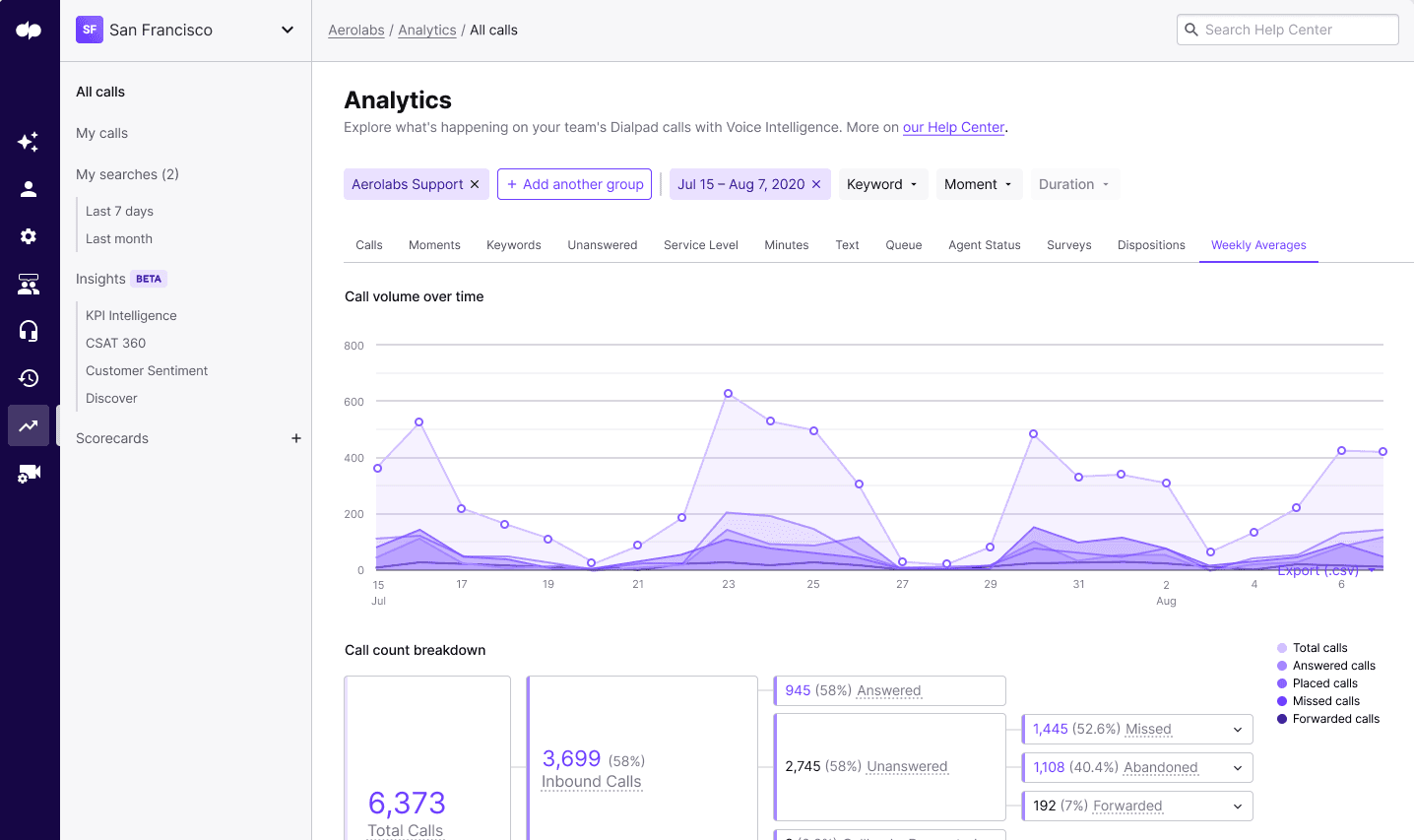The role of AI in contact center operations

Senior B2B SaaS Writer at GetVoIP

Tags
Share
Contact center operations define the customer experience and set the tone for agent productivity. Today, contact center software leverages AI to automate business processes, implement customer feedback, and optimize agent performance.
Natural Language Understanding evaluates customer intent and sentiment, intelligent virtual agents enable 24/7 customer self-service, and generative AI creates post-call summaries highlighting key moments in customer: agent interactions.
What else can AI contact center software do for your business, your customers, and your agents?
Read on to find out in this guide to AI-powered contact center operations.
What are contact center operations?
Contact center operations encompass every business process involved in running a successful contact center, from developing omnichannel routing strategies and customer self-service options to workforce management and KPI monitoring. Though each plays a unique role, call center managers, supervisors, and agents work together to optimize day-to-day and long-term contact center operations.

Contact center managers set service levels, business goals, and metrics to evaluate contact center performance and customer satisfaction levels. Insights from analytics and customer feedback help managers identify contact center problems and tweak big-picture operational strategies accordingly.
Contact center supervisors implement and monitor the manager’s operational strategies. They train and coach agents, respond to KPI alerts, and identify areas for improvement in agent performance and overall operations.
Agents are on the front lines of contact center operations, communicating directly with customers to carry out managerial directives and meet performance targets. Contact center agents receive feedback from managers, supervisors, and customers.
How is AI used in contact center operations?
Contact center operations are complicated, constantly evolving, and impacted by a variety of controllable and uncontrollable factors. Optimizing call center operations is a time-consuming process that, if handled incorrectly, leads to agent burnout, low customer satisfaction scores, and increased operational costs.
Artificial Intelligence (AI) has completely revolutionized call center operations management by automating routine business processes, uncovering the root causes of customer service issues, and identifying opportunities to increase productivity while improving agent performance.
Conversational AI, speech and text analytics, machine learning, Natural Language Understanding (NLU), and Generative AI work in tandem to provide unparalleled customer support, increase employee engagement, and proactively prepare for changes in customer and agent behavior.
Common AI contact center operations include:
Intelligent call routing
Intelligent routing uses natural language processing to evaluate customer intent and real-time agent activity, automatically following preset routing rules to quickly connect customers with the best available live agent.
Skill-based routing eliminates manual transfers and lengthy IVR interactions, lowering the average cost per call. Customers avoid repeating themselves to multiple agents, and are instead connected to the agent with the right skills, training, and schedule to resolve the issue during the first interaction.

Admins can create custom routing rules based on agent schedules, skills, performance scores, department, call groups, language, and location. Routing rules can also be customized by priority, channel, customer relationship, business hours, and more.
Chatbots
Chatbots powered by conversational AI enable customer self-service automation on digital channels, integrating with ticketing, helpdesk, and CRM tools to provide personalized service.
Conversational AI conducts semantic searches of unstructured data to ensure bot-generated responses are as accurate as possible. Chatbots can be pre-programmed with automated workflows, use intelligent routing to transfer customers to live chat agents, and collect invaluable customer journey data.
Agent assist
Real-time agent assist uses NLU, large language models (LLM), and Generative AI (GenAI) to provide automated agent coaching during live customer interaction. Agent Assist recognizes keywords/phrases in customer conversations, then uses GenAI to create instant responses based on internal knowledge base data. These responses can be further personalized via CRM integration.
Agents no longer need to switch between multiple applications during an active conversation, and customers receive relevant, natural-sounding support with responses that use machine learning to improve over time.
Automated quality assurance
Quality assurance (QA) tools use customer interaction AI to monitor and score agent performance in real-time. Admins can customize quality assurance scorecards with Yes/No answers, assign point values to each criteria, and define call purpose.
Managers can review live customer sentiment analysis, provide live agent coaching, and monitor performance KPIs like customer satisfaction score (CSAT), service level objective (SLO), and QA score. They can also enable automatic training module assignments and receive real-time training progress updates.
Customer insights and analytics
AI analytics monitor 100% of omnichannel customer interactions and automatically create detailed KPI reports. Data is collected from a variety of sources, including call transcriptions, chat messages, customer survey responses, and via utterance monitoring.

Interactive reports like heat maps, topic clusters, and business intelligence insights give managers high-level, actionable analytics in seconds. Historical AI reports identify top performers, peak call times, customer sentiment trends, and employee engagement levels.
Live customer intent analysis, real-time service level alerts, and in-call agent assist improve customer satisfaction rates and agent performance.
Forecasting and scheduling
Workforce optimization forecasting tools use predictive analytics, benchmarking, and historical contact center data to optimize the employee scheduling process. Admins can choose from a variety of AI-powered forecasting methods, adjust variables and scenarios, and set custom scheduling rules.
Forecasting helps contact centers proactively prepare for call volume fluctuations, manage agent absenteeism, and optimize staffing levels across voice and digital channels.
Real-time adherence monitoring with automated live schedule adjustments keep call wait times low, while automated PTO and schedule change request approvals keep employee engagement high. Forecasting tools automatically create and implement suggested agent schedules based on predictive analytics and agent scheduling preferences.
✨ WANT TO LEVEL UP YOUR CONTACT CENTER?
Grab the Contact Center Playbook, which breaks down everything you need to know, from setup to staffing to optimizing—with examples from real contact center teams across different industries.
How to integrate AI into your contact center
Whether you want to implement any or all of the above contact center AI features, careful and continual planning is required. Streamlining contact center operations management with AI often means completely rewriting traditional business processes.
Make the onboarding process easier for managers, agents, and customers by following the below steps:
Step one: Define objectives
First, determine why you want to optimize your contact center operations with AI.
Do you want to:
Lower operating expenses and shorten average handle time?
Increase CSAT and NPS scores?
Automate routine business processes and offer 24/7 customer self-service?
Improve customer service and support quality?
Increase first contact resolution rates?
Optimize agent schedules and increase agent retention?
Consider how implementing AI will help you achieve these long and short-term goals, and the specific AI functionalities required to meet these objectives. If you’re struggling to determine how AI can improve your contact center operations, identify common customer pain points, time-consuming business processes, employee complaints, and below-service-level KPIs.
Step two: Set KPIs to monitor operational efficiency
Next, select the specific metrics and KPIs you’ll use to evaluate the efficacy of current contact center workflows and AI’s influence on overall contact center operations.
Review industry benchmarks and set service level agreements (SLAs) for essential KPIs like average handle time, first contact resolution, and average hold time. Filter reports by date range, department, agent, or custom call tag, and drill down individual KPIs for additional insight. Review interactive AI reports on trends in customer survey responses, employee satisfaction, and customer conversations.
Step three: Select AI features and choose CCaaS software
Next, determine which AI-powered features will likely have the biggest impact on contact center operations.
For example, a contact center struggling with agent absenteeism and increased call volumes would benefit the most from forecasting and scheduling tools. A remote contact center with high agent turnover should prioritize performance gamification and agent coaching tools.
Choose which capabilities your contact center needs, then look for a CCaaS provider that offers them.
When evaluating AI contact center software, consider:
Compatible third-party integrations and APIs
Pricing, plans, feature add-ons
Customer support hours, channels, response times, etc.
Ease of use
Current customer reviews
Step four: Train agents and monitor performance
Once you’ve selected your AI CCaaS software, it’s time to train your agents. Most CCaaS providers offer on-demand training webinars, courses, and interactive online knowledge bases to streamline the training process.
Admins can create custom training materials from past call recordings or chat transcripts, then use AI-powered coaching tools to offer 1:1 agent performance feedback. Gamification makes the training and onboarding process more engaging while rewarding top performers.
During the onboarding process, monitor performance across channels, agent groups, and schedules. Use real-time analytics to identify areas for optimization, and monitor end-of-day and weekly KPI reports for additional insights. Collect employee feedback to improve the training process, identify common areas of confusion, and prevent workflow bottlenecks.
Monitor the same KPIs for 1-3 months to get an accurate perception of contact center operations and efficiency.
Step five: Review feedback and adjust KPIs accordingly
Once you’ve monitored KPIs for a few months, you’ll be able to identify clear trends in customer and agent behavior and adjust operations accordingly. To continue to get a complete picture of contact center operations, switch up KPIs, forecasting methods, and other variables.
Benefits of using AI in contact center operations
Integrating AI dramatically improves contact center operations by automating routine business processes, identifying trends in customer sentiment, and optimizing agent schedules.
Additional benefits of using AI in contact centers include:
Cost savings
AI-powered features like intelligent routing, live agent assist, and forecasting tools all dramatically lower contact center operating costs.
Predictive analytics and forecasting optimize employee schedules, helping managers avoid overstaffing, overtime pay, and hiring additional agents. Intelligent routing decreases the average cost per call, shortens hold times, and increases first contact resolution rates.
Better customer experience
AI improves the contact center customer experience across the board, but especially by enabling 24/7 omnichannel self-service and improving the quality of live agent support.
Customers don’t have to wait for available live agents when they need help. They can sign up for an automated customer callback, schedule an appointment via chatbot, or completely resolve their issue via AI-powered virtual assistant.

If customers do need to speak to a live agent, AI tools like agent assist, CRM screen pops, omnichannel skills-based routing keep conversations efficient yet personal.
Automated post-interaction customer satisfaction (CSAT) surveys with AI insights make customers feel valued, help managers identify inconsistencies in employee training, and highlight overall trends in customer sentiment, behavior, and buying patterns.
Decreased agent attrition
It’s no secret that agent attrition is a huge problem for contact centers, driving up operational costs and forcing other employees to pick up the slack.
Artificial Intelligence automates dull and routine business processes like customer account data collection and entry, employee scheduling, and appointment management. Intelligent virtual agents handle basic customer support interactions, while agent assist lets reps copy-paste canned responses during live interactions.
Custom intelligent routing prevents individual agents from getting overburdened. Automated agent scoring tools clarify employee expectations and offer feedback on how to improve.
Gamification tools increase employee engagement by recognizing and rewarding top performers, while employee feedback analytics help managers understand how to improve the agent experience.
Increased productivity
AI doesn’t just make agents happier with their jobs–it also makes them much more productive.
In-conversation AI agent assist means agents no longer need to put callers on hold to find relevant CRM data or verify company policies. Generative AI tools automatically create ideal responses to customer service queries, pulling data from CRM and helpdesk tools to ensure accuracy.
Real-time schedule adjustments make use of all available agents during peak call times, while contact center analytics identify time-consuming business processes and opportunities for automation.
Automated call transcripts and post-call summaries with interaction highlights save hours on quality management. AI also streamlines the performance management process with automated agent scoring, customer survey response analysis, and live SLA alerts.
Long-term operational efficiency
While AI certainly improves short-term contact center operations, machine learning means your agents, business processes, and automated self-service options only get better with time.
AI contact center software collects data from 100% of customer interactions across all channels, comparing the results to industry benchmarks and historical data. Speech and text analytics create interactive data reports with insights impossible to collect manually, providing actionable suggestions to optimize long-term workforce planning strategies and current call center operations.
The future of AI in contact centers
As including AI-powered capabilities in contact center software becomes the standard, expect to see an increased use of generative AI, a focus on AI-powered compliance, and more detailed customer intelligence insights.
Trends in AI impacting contact center operations management include:
Multimodal AI: Given that the multimodal AI market is set to be worth $4.5 billion by 2028, expect to see contact center AI tools that can analyze and generate video and audio formats in addition to text
AI for Supply Management: Leveraging AI capabilities like demand forecasting, predictive analytics, customer sentiment monitoring throughout the supply management process can improve service levels by 65%
AI Compliance: Though automated call transcripts with speech analytics help with compliance monitoring, expect CCaaS tools to include automated break scheduling, transaction monitoring, fraud detection, biometric user verification, and more
Consumer Adoption of AI: Now that nearly 50% of consumers say they’re comfortable interacting with a brand’s AI-powered tools, expect to see far less consumer concern and pushback regarding the widespread adoption of automated customer service
Increased Task Automation: AI can automate up to 70% of the current tasks taking up an employee’s workday–so don’t expect task automation to slow down anytime soon.
Want to see how Dialpad Ai contact center works?
See how it can make your contact center team’s lives easier with a demo or, take a self-guided interactive tour of the app!
